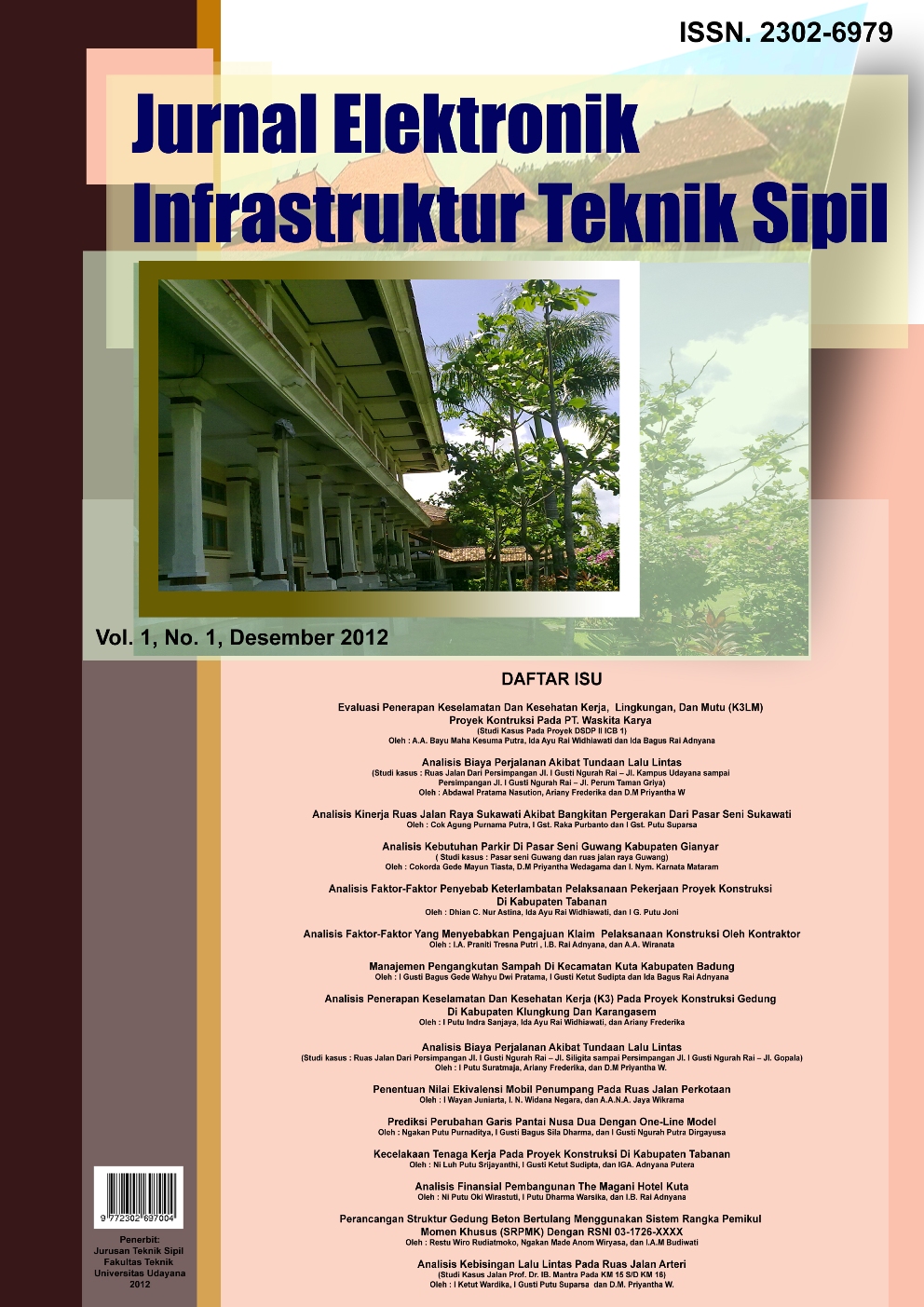ANALISIS PENGELOLAAN PENGANGKUTAN SAMPAH DI KECAMATAN KLUNGKUNG KABUPATEN KLUNGKUNG
Abstract
Abstrak: Meningkatnya pertumbuhan ekonomi dan pertumbuhan penduduk di Kecamatan Klungkung berdampak pula pada perubahan pola hidup masyarakatnya, yang menjadi lebih konsumtif. Hal ini menyebabkan meningkatnya produksi sampah, yang harus dikelola dengan baik, terutama dalam pengangkutannya ke TPA. Tujuan penelitian ini adalah untuk menghitung jumlah dump truck dan arm roll truck yang dibutuhkan untuk mengangkut sampah yang dihasilkan di Kecamatan Klungkung ke tempat pembuangan akhir sampah setempat. Data-data yang dikumpulkan dalam penelitian ini adalah data survei timbulan sampah per kapita dan jumlah penduduk untuk menghitung timbulan sampah Kecamatan Klungkung, serta data survei pengangkutan sampah, yaitu kapasitas bak truk pengangkut sampah, waktu memuat dan menurunkan sampah, waktu perjalanan, jarak perjalanan, dan rute perjalanan. Data sekunder yang dikumpulkan adalah peta Kecamatan Klungkung, rute kendaraan pengangkut, jumlah alat angkut sampah berupa dump truck dan arm roll truck, jumlah penduduk, dan jumlah pasar. Diperoleh hasil bahwa besar timbulan sampah yang dihasilkan di Kecamatan Klungkung pada tahun 2011 adalah sebesar 217,05 m3/hari, dan diprediksi akan meningkat menjadi 233,88 m3/hari pada tahun 2016. Kebutuhan kendaraan pengangkut sampah adalah berupa dump truck sebanyak 8 unit dan arm roll truck sebanyak 3 unit. Jumlah trip yang diperlukan untuk dump truck adalah 26 trip/hari dari tahun 2012 – 2015, 27 trip/hari untuk tahun 2016, sedangkan untuk arm roll truck adalah 2 trip/hari dari tahun 2012 sampai tahun 2016.
Abstract: The increase of economic and population growth of Klungkung District, Bali, have changed the lifestyle of its people to be more consumptive which in turn will increase the production of solid waste. This research aimed to assess the requirement of solid waste transport facilities in Klungkung District. The data collected were solid waste production per capita, truck capacity, length of loading and unloading of the solid waste, length of transportation per trip, distance per trip and transportation routes. Secondary data include Klungkung District map, routes of the transportation vehicles, number of dump trucks and arm roll trucks, the total population, and the number of markets in Klungkung District. These data were used to calculate the volume of waste generated and the number of dump trucks and arm roll trucks required to transfer the solid waste from the producers to the dumping site. It was found that the amount of solid waste generated in the District of Klungkung in 2011 was 217.05 m3/day and it was predicted that it will increase to 233.88 m3/day in 2016. It was also found that 8 units of dump trucks and 3 units of arm roll trucks will be required with the total number of trips for dump truck is 26 trips/day in the year 2012 to 2015, 27 trips/day for 2016, and for arm roll truck is 2 trips/day in the period of 2012-2016.


